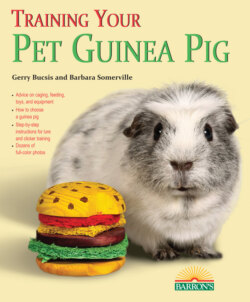Читать книгу Training Your Guinea Pig - Gerry Bucsis - Страница 15
На сайте Литреса книга снята с продажи.
Assembly time
ОглавлениеThe easy part of cage construction is erecting the walls. Just stand the grids up, and join them together with the plastic connectors to form a fence-like rectangle. The number of grids you need depends on how large a cage you’re planning to make. For example, if you want to make a cage approximately 28 inches (70 cm) wide x 84 inches (210 cm) long, you’ll need sixteen grids: two grids for each short side and six grids for each long side. At this point, use the plastic connectors rather than the lock ties to join the grids, because if you change your mind about the size of the cage or the layout, it’s easy to pop off the connectors and reconfigure the walls.
If you’re going to place the cage on the floor, you can skip this paragraph and go straight to the next one. However, if you’re going to place the cage on a desk or a table, you need to buy extra grids to make a wire base for the cage. Why? Sometimes a cage on a table can get knocked or nudged. If it’s nudged in such a way that two adjoining sides end up hanging over the table, the whole cage will come crashing down—guinea pigs and all. To prevent this disaster, you need to make a wire bottom for any cage that’s going to be placed on a table. To do this, just zip-tie some grids together to make a flat base. Then, put the base on the table, set the grid walls on top of the base, and zip-tie everything together. Picture a big shoe box made out of grid panels to get the idea of what this will look like.
The next step is to make a coroplast tray for the cage. This involves cutting and scoring the coroplast, and forming it into a shallow box shape that will fit inside the wire-grid walls. In order to figure out how large a piece of coroplast you’ll need, first measure the inside dimensions of the wire-grid rectangle you’ve just made, and then add 12 inches (30 cm) to the length and 12 inches (30 cm) to the width. Why add the extra inches? It’s because they’ll be needed to form a 6-inch (15 cm) side all around the coroplast tray. This mini wall is important because it keeps hay and bedding inside the cage.
Now, mark these measurements onto the coroplast using a felt-tip pen and a ruler. Next, trim the coroplast along the marked lines with a utility knife or sturdy scissors. Then, using your pen and ruler, draw a six-inch (15 cm) border all the way around the trimmed coroplast. Now comes the hard part—you have to score the coroplast all along the lines you’ve just marked out. Scoring means cutting the plastic partway through with a utility knife or razor blade. Be very careful; you don’t want to cut all the way through (see photo).
You’ll notice that your marked lines intersect at each corner of the coroplast to form a 6-inch square (15 cm) (see photo). Cut right through one line of each square. Now flip the coroplast over, and fold up the scored parts to form a box. Tape the corners securely with good quality duct tape or vinyl-coated cloth tape. What you’ve just made is a shallow tray with 6-inch (15 cm) sides. Set the tray inside the wire walls and presto—you have an inexpensive, spacious guinea pig cage! The last step is to reinforce all the adjoining grid sections with zip ties (top, bottom, and center). This gives the walls added strength. Be sure to trim those zip ties so that you and the piggies don’t get scratched.
If you have space for an even larger cage—one that will allow you to use the whole sheet of coroplast without trimming off any part of it—stick with six grids for the long walls, but use three grids for the short walls. The third grid at each short end will have to overlap the second grid and be secured to it with zip ties.
When scoring the coroplast, be careful not to cut right through it.
To make a corner, cut through one line of each square.
What about a lid or cover for the cage? Since guinea pigs aren’t champion high jumpers, you don’t really need to add a lid. But if you have other pets, such as a cat or a dog, you should top the cage with a cover to keep your cavies safe. Two lengths of epoxy-coated wire closet shelving will make a fine cover. The length of the cage will determine how long the pieces of shelving need to be. If the shelving overlaps the cage by a few inches, you won’t have to bother cutting it. But, if it’s longer and needs to be trimmed, use bolt cutters or a hacksaw, and cap the rough edges with plastic end caps. Join the two pieces of shelving together lengthwise with zip ties, and set this homemade lid on top of the cage. If you want to secure the lid to the cage, hook on a few bungee cords.
A C&C cage makes the best guinea pig habitat.
When you’re building a do-it-yourself cage, the easiest type to make is a rectangular one. But if you’re really handy, why not browse the Internet or go on YouTube to get ideas and instructions for more elaborate L-shaped or multi-level designs? Let your imagination run wild! For serious do-it-yourselfers, a custom-made guinea pig cage can be a really fun project.
